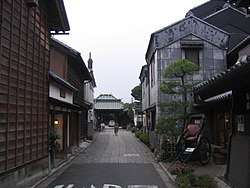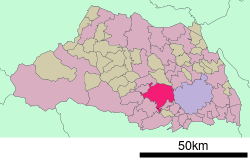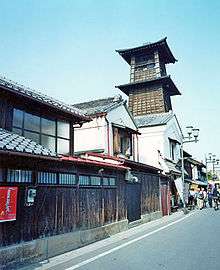Kawagoe, Saitama
| Kawagoe 川越市 | |||
|---|---|---|---|
| Core city | |||
 Traditional alley in Kawagoe | |||
| |||
 Location of Kawagoe in Saitama Prefecture | |||
 Kawagoe Location of Kawagoe in Saitama Prefecture | |||
| Coordinates: 35°55′30.5″N 139°29′8.8″E / 35.925139°N 139.485778°ECoordinates: 35°55′30.5″N 139°29′8.8″E / 35.925139°N 139.485778°E | |||
| Country | Japan | ||
| Region | Kantō | ||
| Prefecture | Saitama Prefecture | ||
| Area | |||
| • Total | 109.13 km2 (42.14 sq mi) | ||
| Population (February 2016) | |||
| • Total | 350,421 | ||
| • Density | 3,210/km2 (8,300/sq mi) | ||
| Time zone | UTC+9 (Japan Standard Time) | ||
| - Tree | Oak | ||
| - Flower | Kerria | ||
| - Bird | Goose | ||
| Phone number | 049-224-8811 | ||
| Address | 1-3-1 Motomachi, Kawagoe-shi, Saitama-ken 350-8601 | ||
| Website | www.city.kawagoe.saitama.jp | ||
Kawagoe (川越市 Kawagoe-shi) is a city in Saitama Prefecture, Japan. As of 1 February 2016, the city had an estimated population of 350,541, and a population density of 3,210 persons per km². Its total area is 109.13 km². The city is known locally as "Little Edo" (小江戸 Koedo) after the old name for Tokyo, due to its many historic buildings.
Geography
Located in the Musashino Terrace of central Saitama Prefecture, both the Arakawa and the Tamagawa Rivers flow through the city, which is approximately 30 kilometers from downtown Tokyo.
Surrounding municipalities
History
During the Edo period Kawagoe Castle was the headquarters of the Kawagoe Domain under the Tokugawa shogunate. After the Meiji restoration, it briefly became capital of Kawagoe Prefecture (1871) then Iruma Prefecture (1871–1873), before becoming part of Saitama Prefecture.
The modern town of Kawagoe was created within Iruma District, Saitama with the establishment of the municipalities system on April 1, 1889. A large part of the town was destroyed in a fire on May 13, 1893 and was rebuilt with many structures using construction techniques of traditional kura warehouses. On December 1, 1922 Kawagoe merged with neighboring Senba Village, and was elevated to city status, with a population of 30,359. It was the first municipality in Saitama Prefecture to receive city status.
The village of Tanomozawa was annexed in 1939. The city escaped World War II with only minor damage. The city expanded in 1955 by annexing the villages of Yoshino, Furuya, Minamifuruya, Takashina, Fukuhara, Daito, Kasumigseki, Naguwashi and Yamada. In December 1999, the old core of Kawagoe was designated a Historic Preservation District. On April 1, 2003, Kawagoe was designated a core city with increased local autonomy.
Education
Universities and colleges
- Toyo University - Kawagoe campus
- Tokyo International University
- Toho College of Music
- Shobi University
- Saitama Medical University – Kawagoe campus
Primary and secondary education
Kawagoe has one private and 33 public elementary schools, 22 public middle schools and four private combined middle/high schools. The city has eight public and three private high schools. Kawagoe also has three special education schools.
Transportation
Rail
Highway
Cycling
The city of Kawagoe operates a bicycle sharing scheme in the city centre, with eight pickup/parking locations.[1]
Twin towns and sister cities
Kawagoe is twinned with the following six municipalities in Japan and worldwide.[2]
Japan



Worldwide
Local attractions

Kawagoe is famous for its sweet potatoes, and the local "Candy Street" sells such treats as sweet potato chips, sweet potato ice cream, sweet potato coffee, and even sweet potato beer, brewed at the local Koedo Brewery. Some of its streets preserve the old castle town of the Edo period (17th to 19th centuries).
Sights

- Bell of Time (時の鐘 Toki no kane) is a bell tower originally built on the orders of Sakai Tadakatsu (酒井 忠勝) between 1624 and 1644. The present structure goes back to 1894, a year after the Great Fire of Kawagoe. It is a three-story tower measuring 16 meters in height. The tower has been telling time to the city's residents for 350 years and has been deemed as a symbol of the city. Currently, the bell can be heard four times a day (6 AM, 12 PM, 3 PM and 6 PM) [5]
- Confectionery Row (菓子屋横丁 Kashiya Yokochō) is a small backstreet alley where a dozen stores sell old-fashioned cheap sweets and snacks, most of which are priced at less than 50 yen. The location was known as a neighborhood where scores of confectionery manufactures lined the alley. Many tourists come here to enjoy the nostalgic atmosphere of the early Shōwa period.[6]
- Kurazukuri Street (蔵造りの町並み Kurazukuri no machinami) is lined with traditional warehouses constructed in a style called kurazukuri (蔵造り) and maintains the style of the Edo period. The city of Kawagoe started seeing kurazukuri-style warehouses in the aftermath of a great fire that consumed one-third of the old Kawagoe in 1893. Within and beyond the Kurazukuri Street, many warehouses from the 18th and 19th centuries can still be seen. The Kawagoe Kurazukuri Museum is located in a traditional warehouse built in 1893 and allows its visitors to walk around inside and experience the life of Edo merchants.[7] The artisan shops in the area include Machikan, a sword and knife manufacturer in operation for generations.[8]
Festivals
Kawagoe Festival is held every year on the third Saturday and Sunday of October. In 2016, it was designated as a "Intangible cultural heritage".[9]
Notable people from Kawagoe
- Asada Nobuoki, General in the Imperial Japanese Army
- Hisako Higuchi, professional golfer
- Masachika Ichimura, actor
- Nobutaka Shiōden, General in the Imperial Japanese Army
References
- ↑ 川越市自転車シェアリングを実施します [Kawagoe to introduce bicycle sharing scheme] (in Japanese). Japan: City of Kawagoe. 2013. Archived from the original on 2014-01-13. Retrieved 13 January 2014.
- ↑ 姉妹友好都市交流 [Twin cities] (in Japanese). Japan: Kawagoe International Center. 2003. Archived from the original on 14 April 2009. Retrieved 29 November 2014.
- 1 2 "International Exchange". List of Affiliation Partners within Prefectures. Council of Local Authorities for International Relations (CLAIR). Archived from the original on 4 January 2016. Retrieved 21 November 2015.
- ↑ "US-Japan Sister Cities by State". Asia Matters for America. Honolulu, HI: East-West Center. Retrieved 20 November 2015.
- ↑ Kawagoe City website. Retrieved on 5 September 2008
- ↑ Kawagoe City website. Retrieved on 4 September 2008
- ↑ Kawagoe Kuradukuri Museum website. Retrieved on 4 September 2008
- ↑ The Traditionalist Afar magazine
- ↑ Kawagoe Festival official website Retrieved 21 January 2013
External links
| Wikimedia Commons has media related to Kawagoe, Saitama. |

- Official Website (in Japanese)
- Little Edo: The Ultimate guide to visiting the 400-year old district of Kawagoe (in Japanese)

